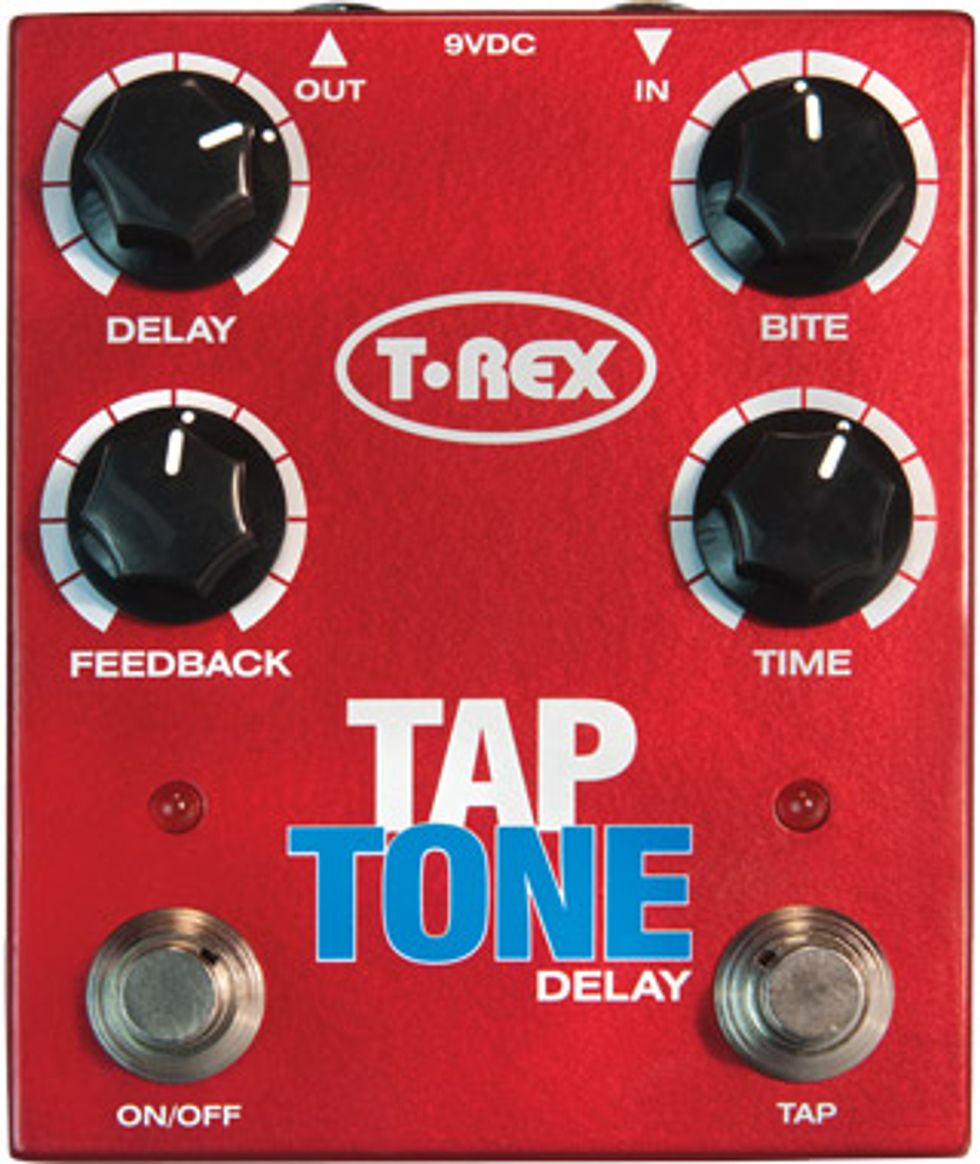
Denmark’s T-Rex Effects is famous for making high-quality pedals, having a unique and forward-looking design sensibility, and delivering an impressive array of effects that cover a crazy range of tones. The company isn’t shy about creating numerous takes on a specific effect type, and they clearly enjoy the many possible flavors of delay. Replica and Reptile delays are among T-Rex’s most popular products, ending up on the pedalboards of Carlos Santana, John Mayer, and Pete Townshend. T-Rex’s great tones don’t come cheap though, so T-Rex set out to design a stripped-down delay machine that offers the same repeating boutique tones, but at a price that more players can swing. The Tap Tone is the fruit of those efforts.
There’s a Tap for That
Controlling the Tap Tone is
pretty straightforward stuff.
Three of the controls—delay,
feedback, and time—are all
conventional and familiar
parameters. The fourth knob,
bite, is a voicing control, which
sweeps through a range from
crystal clear delay to dirtier,
analog repeats that approximate
those generated by old tape
delays. And if you hate having
to lean down to twist a knob
to change the timing of the
repeats, the pedal includes a
handy footswitch for tapping in
the desired rhythm with your
foot (it isn’t called Tap Tone for
nothing). The whole shebang
is packed into a solid enclosure
that can be powered by either a
9V battery or wall wart.
Ratings
Pros:
Accurate repeats with no noticeable
digital coloration. Great tone for the money.
Cons:
While chorus effects are possible, no
separate modulation features are present.
Tones:
Ease of Use:
Build:
Value:
Street:
$149
T-Rex Effects
t-rex-effects.com
Timing Is Everything
While it doesn’t pack all the
sounds lurking within its big
brother, the Reptile, the Tap
Tone’s basic tonality is in the
same ballpark. A Stratocaster
and a clean Mesa/Boogie
reveals that the Tap Tone’s clean
repeats match the bypassed tone
with pinpoint accuracy, and
the pedal has an exceedingly
smooth and natural response to
picking dynamics. Strike a note
with more force, and the repeats
replicate the dry tone with
the same attack and harmonic
content. Similarly, the repeats
fall back in the mix when you
play with a more relaxed style.
Rarely does a digital delay in
this price range react this musically.
And while the available
delay time on tap isn’t going
to match the long two-second
speeds you’ll encounter in some
digital delays, the Tap Tone can
go toe-to-toe with loads of analog
delay pedals that max out in
the 550 ms range.
More players are demanding the flexibility of a tap-tempo feature these days, and it’s implemented beautifully in the Tap Tone. With a couple of quick taps on the dedicated tap switch you can corral long repeats into intense slapback ricochets with ease. And you won’t hear the discernible popping that plagues many other tap pedals—an extra-mile touch that makes this pedal practical and fun to use onstage.
Turning up the bite control gradually stirs the stew to a warm, lo-fi, warbling simmer, filling the spaces in chords with tasty analog color. A bit more dirt at the highest settings would definitely please lo-fi freaks, but the Tap Tone excels at warm focus—a tradeoff most players will be happy to make at this price. You can create deep and detailed chorus-like tones simply by dialing in a shorter delay time and adjusting the delay control to taste.
The Verdict
Repeat-for-repeat, the T-Rex
Tap Tone is an impressive
performer and a great value.
It’s intuitive and easy to use,
has a lovely analog warmth
that can verge on tape-delay
coloration, and is very sturdy.
The bite control could deliver
a hair more grit, but the pedal’s
overall refinement is more than
adequate compensation. In a
crowded mid-price delay field,
the Tap Tone is right at the
head of the class.













![Rig Rundown: Russian Circles’ Mike Sullivan [2025]](https://www.premierguitar.com/media-library/youtube.jpg?id=62303631&width=1245&height=700&quality=70&coordinates=0%2C0%2C0%2C0)













